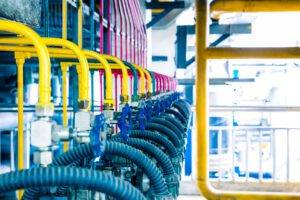Industrial washing systems – such as the ones provided by DBM Technologies – are specialized machinery used to clean objects, artifacts and components in various manufacturing sectors.
In this article, we would like to speak about how these systems work and explore their characteristics, discussing different possibilities of their applications.
Industrial washing systems: what they are
Industrial washing systems employ various techniques to ensure thorough cleaning of objects and the removal of contaminants across different advanced sectors.
There are various types of industrial washing systems, depending on the type of solvent that they use.
The most known are 3:
Water-based washing systems
It uses water as the primary solvent to remove dirt, grease, and other surface contaminants. Water is typically combined with detergents or additives to enhance the effectiveness of the process.
Low-boiling solvent washing machinery
It utilizes chemical solvents with a low boiling point, below 50°C. These solvents effectively remove oily contaminants and fats from heat-sensitive materials without causing damage.
Modified alcohol industrial washing systems
It employs modified alcohol as a cleaning agent, which is effective in removing dirt, oils, and fats. They have a small footprint and low pollutant emissions. It is a subcategory of solvent washing and, unlike low-boiling washing, it operates at temperatures above 100°C and works under vacuum to lower the boiling temperature reached in the process. Additionally, the washing medium used is more cost-effective than others.
So, the choice among these categories depends on the specific needs of the company and the nature of the materials to be treated.
Advantages and applications of industrial washing systems
For every washing need, there is an appropriate system, because every industrial washing structure has its own application, based on the sector, the required level of cleaning and technical specifications.
Water-based washing – for example – is useful for cleaning polar contaminants (dirt, residues, etc.) soluble in water.
It finds application in sectors requiring a higher level of precision cleaning or specific demands, such as in the medical or aerospace industries.
It is used for more complex processes like stripping, pickling, and processes involving chemical agents.
Solvent washing is instead employed for non-polar and water-insoluble contaminants such as dirt and residues.
The washing medium is not subject to degradation over time and is continually distilled, maintaining effectiveness throughout the process.
This technique does not require disposal and consequently reduces associated management costs.
Each type of washing has different applications.
H3: What are the parameters to consider when choosing the right industrial washing system?
For choosing the best industrial washing system for your needs, you need to consider:
Material characteristics: delicacy, tolerance to high temperatures, susceptibility to oxidation, etc.
Type of contaminant present.
Piece geometry.
Available space for machinery installation.
Final quality and required cleanliness level.
Productivity in relation to the quantities of pieces to be washed.
For example, eyewear and accessory sectors, as well as jewelry and watchmaking, need residue-free solutions with customizable cycles, preparing surfaces for subsequent painting or PVD treatments.
In the medical sector, where washing quality must be perfect, attention is also given to the drying phase to prevent bacteria formation.
For washing automotive die-cast components, tunnel or rotating table washing is needed.
Ultrasonic washing systems are also a different way to ensure productivity and excellent qualitative outcomes for cleanliness, even in complex washing processes.
Low-boiling vacuum washing systems assure reduced operating costs and high productivity.
What’s the best one for your business?
Read more:
Features and applications of industrial washing systems
















